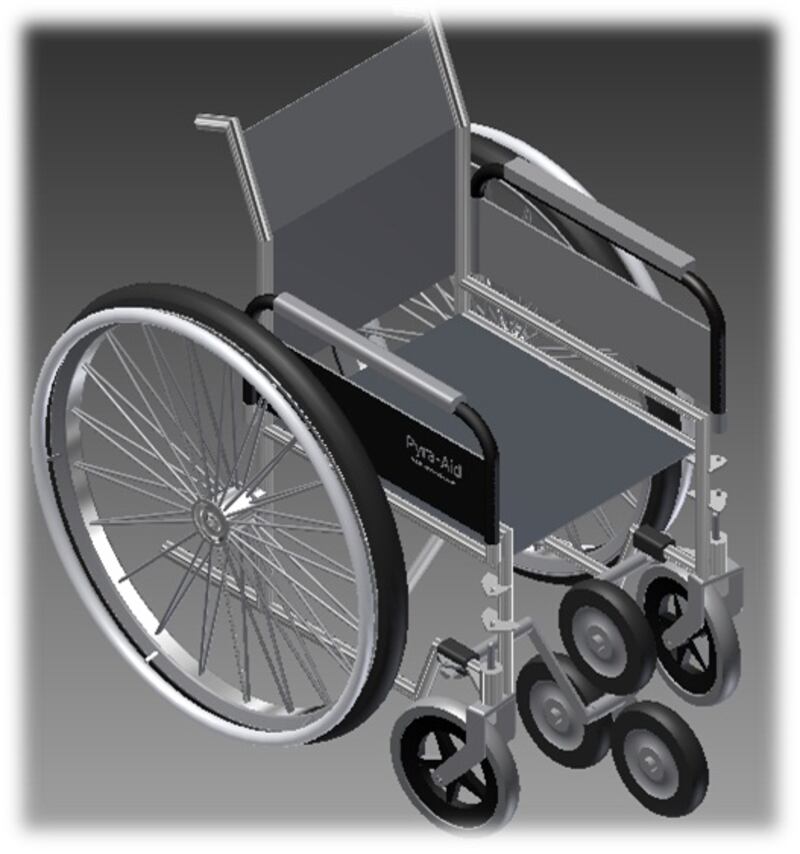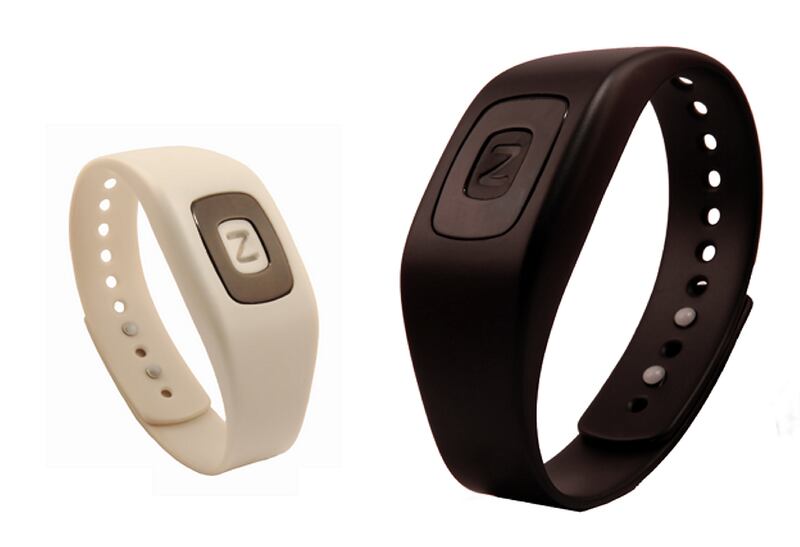A HELP-UP FOR WHEELCHAIR USERS
In an ideal environment, a wheelchair user would not need to negotiate steps or kerbs. But we live in the real world, and situations can arise where a person using a wheelchair has to negotiate such obstacles.
A group of students at Cork Institute of Technology has come up with a potentially simple solution that could help. The Pyra-Aid (TM) is a prototype three-wheeled device that attaches to a wheelchair, is powered by momentum and gives an extra bit of lift to help raise the front wheels up a step.


The idea came when the students were working together on an innovative product design module, explains John Roberts, who is a student of mechanical engineering at CIT and who worked on the project with other students from biomechanical engineering and business. “We had to come up with a product from scratch – from concept right through to business plan,” he says.
One of the students knew a wheelchair user who had to negotiate a tricky step on the way to work, and while brainstorming they came up with the idea of a wheelchair aid. But why three wheels?
“One of the students had seen three-wheeled hand trolleys used for bringing loads up stairs, and we thought why not alter that concept so it could be applied to a wheelchair,” says Roberts.
But while the trolley provided the inspiration, developing a device that could fit onto a wheelchair was a different story. The students realised they needed to talk to people who experienced the obstacles first-hand.
“We weren’t aware of the difficulties that are out there for wheelchair users, so we talked to wheelchair users to find out more,” says Roberts. “Then we set about systematically designing the device – how it was going to work and attach to the wheelchair.”
Importantly, the approach uses no electronics or pneumatics. Instead it simply starts to rotate when the wheel hits the kerb and it’s powered by the momentum of the user, he explains.
Their initial prototype showed promise, and the positive feedback inspired Roberts to take the project further into his final year undergraduate project. In recent months he has been getting back to the basic engineering and stress analysis of the device, and he recently won the Speak Out for Engineering Award for his presentation on the project.
“I am on my third prototype and getting to the stage where I could actually ask people to test it and it would be able to take the wear and tear of contacts with kerbs,” he says.
And while there’s a way to go yet to have a commercial product, Roberts feels the basic and universal nature of the device should work in its favour.
“We set out to come up with a cheap affordable product that is very easily universally attached to different wheelchairs,” he says. “When you take all the complicated electrics out, you potentially have a product that lasts longer and is cheaper to manufacture. So it should be more available to users.”
GOOD VIBRATIONS TO WAKE YOU UP
If you have difficulty hearing, then a new vibrating wrist-band alarm could be just the thing to make sure you wake up on time. Called the ZBand, you simply programme in what time you want the alarm to go off, put the band on your wrist and at the chosen time the device vibrates to rouse you from your slumber.
It’s the brainchild of Paul Griffin, originally from Mayo but now based in Dublin. He was jolted into forming the idea several years ago when an audible alarm got him out of the wrong side of the bed. “One morning I woke up with the alarm blaring and I thought there has to be something better than this,” he recalls.
Griffin hit on the idea of a wearable, vibrating alarm but when he searched online couldn’t find anything that fit the bill. So he enlisted Declan Leonard, also from Mayo, who has a background in IT and they set about developing the ZBand.
It’s a simple concept – you use your phone, tablet or computer to programme the times and intensities of the vibrations, and then you pop the wristband on – but getting the details right took some time, according to Griffin. “Getting the right Bluetooth kit sets and batteries and the testing, it took longer than I thought,” he says.
The work paid off though when the product started to ship in February this year, and in just a few months it has already been sent to around 24 countries.
So how do you use it? Basically the band gets its instructions from an app or programme that is free to download onto a phone or computer (see below for compatibility) and lets you set the parameters you want.
“You can set multiple alarms, a snooze function and programmable vibration strength for whether you are a light sleeper or a heavy sleeper, and at the set time the band vibrates to give you a gentle awakening without disturbing anyone else,” explains Griffin. “There’s one button on the wristband itself, and when the alarm goes, if you press the button it snoozes and if you hold it down for three seconds it turns off the alarm.”
Originally Griffin had designed it for couples where one person wants to wake up without disturbing the other, but he is now seeing that the band is well received by people who have difficulty hearing the sound-based alarm too, and the ZBand could also be useful for discreet reminders during the day.
Available online at zband.biz the system currently retails at €39.99 and is compatible with Android and Windows Mobile 8 for smartphones and tablets, Windows 8 Desktop, Windows 7 and Windows Vista for Windows desktop – the laptop or desktop will need to have Bluetooth to “talk” to the band – and the ZBand does not work on the iPhone platform.
A SMART IDEA TO HELP PREVENT
PRESSURE SORES
Sitting in one position for long periods can push up the risk of developing pressure sores. So a collaboration between Letterkenny Institute of Technology and LC Seating is looking to develop a wireless alert system using "smart fabrics" that can signal wheelchair users when it's time for their position to change.
The project, which has just started, links the Sligo-based company with the Wireless Sensor Applied Research (WiSAR) lab in Letterkenny.
The lab has a focus on research into wireless sensors and in particular the communication of wireless devices implanted in or worn on the body, explains Dr Nick Timmons, a principal investigator at the WiSAR lab.
“We are funded mainly by Enterprise Ireland, and one of our remits is to go out and help companies in the region, so through emails we got in contact with Luke Conway from LC Seating,” he says.
They soon realised they could collaborate to develop a relatively cost-effective approach to wireless monitoring of wheelchair users who would be at risk of developing pressure sores.
“We wanted to bring technology into this where you could warn that the person [in the wheelchair] would need to be moved after being in one position for a certain amount of time,” explains Dr Timmons, who is also a a lecturer in LYIT School of Engineering.
“The whole problem is that once pressure sores start they are very difficult to deal with, so prevention is the main thing. And it’s understood that if people are regularly moved then the pressure doesn’t build up. So the idea here is we develop a ‘smart cushion’ that can detect and monitor the pressure and we can send wireless alerts to a monitor.”
Key to the approach are smart fabrics that change their electrical properties when stretched, and the team has been evaluating different types.
“In general terms the conductive properties [of the materials] change when they are stretched,” explains Dr Timmons. “So they have an electrical resistance property which changes and we can sense that and turn it into a signal.”
Even though it’s still in its early stages, the project has already been seeing encouraging results from testing the smart fabrics, according to Dr Timmons.
And ultimately the hope is that the smart fabric on a cushion could sense that the person has not moved for a particular amount of time and then send an alert – possibly even through a smartphone – to a carer or the person themselves.
“People who have paralysis may be able to move themselves, but if they don’t have any feeling then they are not being warned by pain,” he says. “In that case a local reminder, a simple notification for them could be very useful.”


















